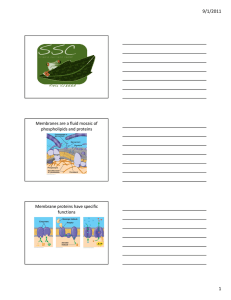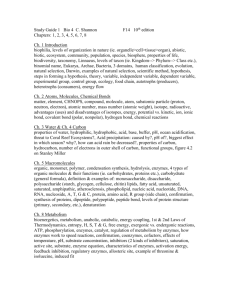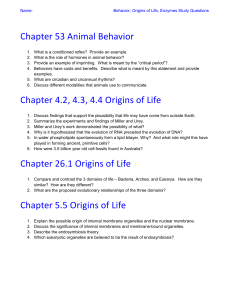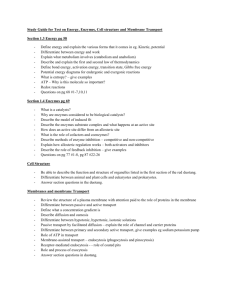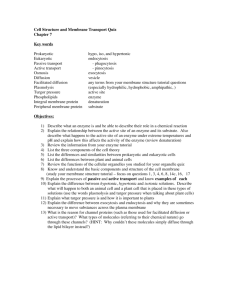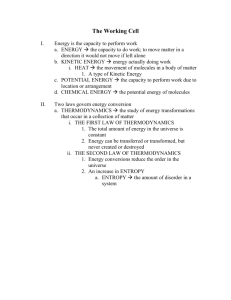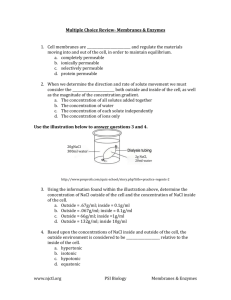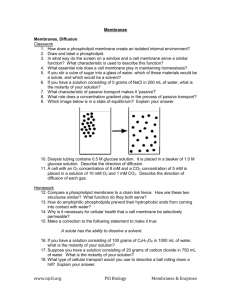Biology-1 Ch. 5 The Working Cell Lecture Outline 1 – – – – – –
advertisement
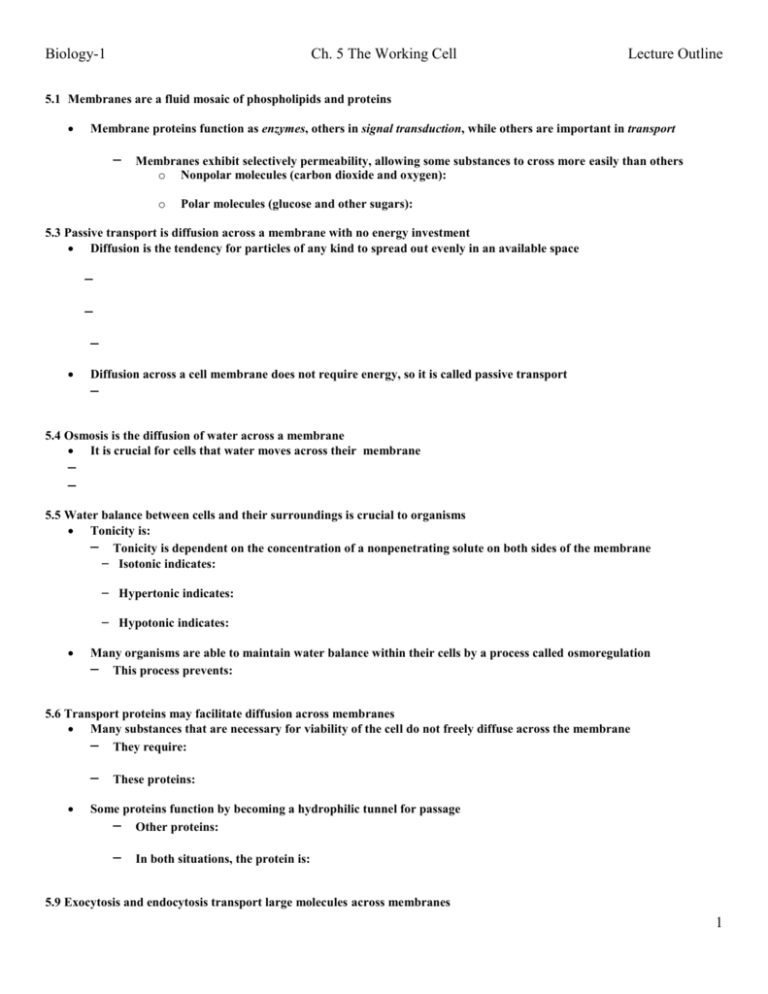
Biology-1 Ch. 5 The Working Cell Lecture Outline 5.1 Membranes are a fluid mosaic of phospholipids and proteins Membrane proteins function as enzymes, others in signal transduction, while others are important in transport – Membranes exhibit selectively permeability, allowing some substances to cross more easily than others o Nonpolar molecules (carbon dioxide and oxygen): o Polar molecules (glucose and other sugars): 5.3 Passive transport is diffusion across a membrane with no energy investment Diffusion is the tendency for particles of any kind to spread out evenly in an available space – – – Diffusion across a cell membrane does not require energy, so it is called passive transport – 5.4 Osmosis is the diffusion of water across a membrane It is crucial for cells that water moves across their membrane – – 5.5 Water balance between cells and their surroundings is crucial to organisms Tonicity is: – Tonicity is dependent on the concentration of a nonpenetrating solute on both sides of the membrane – Isotonic indicates: – Hypertonic indicates: – Hypotonic indicates: Many organisms are able to maintain water balance within their cells by a process called osmoregulation – This process prevents: 5.6 Transport proteins may facilitate diffusion across membranes Many substances that are necessary for viability of the cell do not freely diffuse across the membrane – They require: – These proteins: Some proteins function by becoming a hydrophilic tunnel for passage – Other proteins: – In both situations, the protein is: 5.9 Exocytosis and endocytosis transport large molecules across membranes 1 Biology-1 – Ch. 5 The Working Cell Lecture Outline A cell uses two mechanisms for moving large molecules across membranes Exocytosis is used to: – Endocytosis is used to: In both cases material to be transported is: There are three kinds of endocytosis – Phagocytosis is: – Pinocytosis i: – Receptor-mediated endocytosis is: ENERGY AND THE CELL 5.10 Cells transform energy as they perform work Cells are small units, a chemical factory, housing thousands of chemical reactions – The result of reactions is: 5.11 Two laws govern energy transformations Energy transformations within matter are studied by individuals in the field of thermodynamics – Biologists study thermodynamics because: It is important to understand two laws that govern energy transformations in organisms – The first law of thermodynamics— – The second law of thermodynamics— – Entropy is: 5.12 Chemical reactions either release or store energy An exergonic reaction is: – This reaction: – Burning wood : – Cellular respiration: An endergonic reaction requires: – The reactants: – Photosynthesis makes: A living organism produces thousands of endergonic and exergonic chemical reactions – – A metabolic pathway is: 2 Biology-1 Ch. 5 The Working Cell Lecture Outline A cell does three main types of cellular work – Chemical work— – Transport work— – Mechanical work— To accomplish work, a cell must manage its energy resources, and it does so by energy coupling— 5.13 ATP shuttles chemical energy and drives cellular work ATP, adenosine triphosphate, is the energy currency of cells. – ATP is: – It is composed of: Hydrolysis of ATP: – The transfer is called: – In the process: HOW ENZYMES FUNCTION 5.14 Enzymes speed up the cell’s chemical reactions by lowering energy barriers Although there is a lot of potential energy in biological molecules, such as carbohydrates and others, it is not released spontaneously – – This energy is called: The cell uses catalysis to drive (speed up) biological reactions – Catalysis is accomplished by: – Enzymes: – Each enzyme has a particular target molecule called the substrate 5.15 A specific enzyme catalyzes each cellular reaction Enzymes have unique three-dimensional shapes – – As a result of its shape: – The substrate’s chemistry is: For optimum activity, enzymes require certain environmental conditions – Temperature: – High temperature: – Enzymes also require: 3 Biology-1 Ch. 5 The Working Cell Lecture Outline Some enzymes require nonprotein helpers – Cofactors: – Coenzymes: 5.16 Enzyme inhibitors block enzyme action and can regulate enzyme activity in a cell Inhibitors are chemicals that inhibit an enzyme’s activity – One group inhibits because: – These are called: Other inhibitors do not act directly with the active site – – These are called: – Enzyme inhibitors are important in regulating cell metabolism Often the product of a metabolic pathway: – The more product formed: 4
